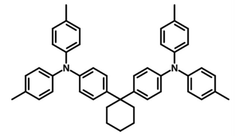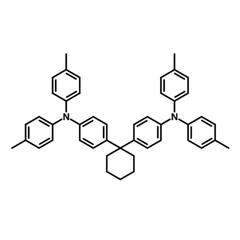TAPC
CAS Number 58473-78-2
Electron / Hole Transport Layer Materials, High Purity Sublimed Materials, Host Materials, Semiconducting Molecules
TAPC, hole transport material for OLEDs
High hole mobility and can be used to simplify OLED structures
1,1-Bis[(di-4-tolylamino)phenyl]cyclohexane, known as TAPC, has been widely used as a hole transport material in organic light-emitting diodes (OLEDs) due to its high hole mobility.
Having a higher ET (2.87 eV) than the typical blue phosphorescent guest material, TAPC can be used as both hole-transport layer material and as host for blue phosphorescent (such as FIrpic) guest molecules, resulting in a reduction of the number of organic layers and simplified OLED structures.
General Information
| CAS number | 58473-78-2 |
|---|---|
| Chemical formula | C46H46N2 |
| Molecular weight | 626.87 g/mol |
| Absorption | λmax 305 nm (in THF) |
| Fluorescence | λem 414 nm (in THF) |
| HOMO/LUMO | HOMO = 5.5 eV, LUMO = 2.0 eV |
| Synonyms |
|
| Classification / Family | Triphenylamine derivatives, Hole-injection layer (HIL) materials, Hole transport layer (HTL) materials, Electron blocking layer (EIL) materials, Phosphorescent host materials, Thermally-activated delayed fluorescence (TADF) materials, Organic light-emitting diodes (OLEDs), Organic electronics |
Product Details
| Purity |
>99.5% (sublimed*) >98.0% (unsublimed) |
|---|---|
| Melting point | 186 °C (lit.) |
| Appearance | White powder/crystals |
*For more details about sublimation, please refer to the Sublimed Materials.
Chemical Structure

Device Structure(s)
| Device structure | ITO(50 nm)/PEDOT:PSS(60 nm)/TAPC(20 nm)/mCP(10 nm)/mCP:BmPyPb*:4CzIPN(25 nm)/TSPO1(35 nm)/LiF(1 nm)/Al(200 nm) [1] |
|---|---|
| Colour | Green |
| Max. EQE | 28.6% |
| Max. Power Efficiency | 56.6 lm W−1 |
| Device structure | ITO/TAPC (40 nm)/TCTA (2 nm)/26DCzPPy:TCTA:FIrpic (0.4:0.4:0.2) (5 nm)/26DCzPPy:PPT:FIrpic (0.4:0.4:0.2) (5 nm)/3TPYMB (55 nm)/CsF (2 nm)/Al (180 nm) [2] |
|---|---|
| Colour | Blue |
| Current Efficiency @ 1000 cd/m2 | 42 cd/A |
| Power Efficiency @ 1000 cd/m2 | 30 lm W−1 |
|
Device structure |
ITO/TAPC:MoOx (10 nm, 15 wt.%)/TAPC(35 nm)/TcTa:Ir(BT)2(acac) (5 nm, 4 wt.%)/26DCzPPy:FIrpic (5 nm, 15 wt.%)/26DCzPPy:Ir(BT)2(acac) (5 nm, 4 wt.%)/BPhen (40 nm)/Cs2CO3 (1 nm)/Al (100 nm) [3] |
| Colour | White |
|---|---|
| Max. EQE | 13.2% |
| Max. Current Efficiency | 35.0 cd/A |
| Max. Power Efficiency | 30.6 lm W−1 |
|
Device structure |
Si/SiO2/Al (80 nm)/MoOx: TAPC (43 nm, 15 wt.%)/TAPC (10 nm)/Ir(piq)3:TcTa (3 nm, 6%)/TcTa (2 nm)/FIrpic:26DCzPPy (5 nm, 12 wt.%)/BPhen (2 nm)/PO-01*:26DCzPPy (5 nm, 6 wt.%)/BPhen (40 nm)/Cs2CO3 (1 nm)/Al (2 nm)/Cu (18 nm)/TcTa (60 nm) [4] |
| Colour | White |
|---|---|
| EQE @ 1000 cd/m2 | 10% |
| Current Efficiency @ 1000 cd/m2 | 25.6 cd/A |
| Power Efficiency @ 1000 cd/m2 | 20.1 lm W−1 |
| Device structure | ITO (90 nm)/HATCN (5 nm)/TAPC (65 nm)/10 wt% fac -Ir(mpim)3 –doped TCTA (5 nm)/10 wt% fac -Ir(mpim)3 -doped 26DCzPPy (5 nm)/B3PyPB* (65 nm)/Liq (2 nm)/Al (80 nm) [5] |
|---|---|
| Colour | Blue |
| EQE @ 100 cd/m2 | 29.6% |
| Current Efficiency @ 100 cd/m2 | 73.2 cd/A |
| Power Efficiency @ 100 cd/m2 | 75.6 lm W−1 |
| Device structure | ITO/TAPC (40 nm)/TcTa (10 nm)/5a* (4%):TcTa (5 nm)/5a* (4%):26DCzPPy (10 nm)/TmPyPB (40 nm)/LiF(1 nm)/Al(100 nm) [6] |
|---|---|
| Colour | Red |
| Max. Luminance | 11,023 cd/m2 |
| Max. Current Efficiency | 17.36 cd/A |
| Max. Power Efficiency | 14.73 lm W−1 |
| Device structure | ITO /TAPC/(1wt% DPB:99wt%tri-PXZ-TRZ*):CBP (15:85)/LiF/Al [7] |
|---|---|
| Colour | Red |
| Max EQE | 17.5% |
| Max. Power Efficiency | 28 lm W−1 |
| Device structure | ITO (180 nm)/TAPC (60 nm)/mCP:Firpic–8 wt% (10 nm)/Ir(ppz)3 (1.5 nm)/mCP:Firpic–8 wt% (10 nm)/Ir(ppz)3 (1.5 nm)/mCP:Firpic–8 wt% (10 nm)/TPBi (30 nm)/Liq (2 nm)/Al (120 nm) [8] |
|---|---|
| Colour | Blue |
| Luminance @ 200 cd/m2 | 32,570 cd/m2 |
| Max. Current Efficiency | 43.76 cd/A |
| Max. EQE | 23.4% |
| Max. Power Efficiency | 21.4 lm W−1 |
| Device structure | ITO/TAPC (50 nm)/TcTa:FIrpic (7%,10 nm)/26DCzPPy:FIrpic (20%, 10 nm)/Tm3PyPB (20 nm)/Tm3PyPB:Cs (30 nm)/LiF (1 nm)/Al (120 nm) [9] |
|---|---|
| Colour | Blue |
| Max. EQE | 20.3% |
| Max. Power Efficiency | 36.7 lm W−1 |
| Device structure | ITO/MoO3 (8 nm)/(NPB)(80 nm)/TAPC(5 nm)/TCTA:4 wt% Ir(MDQ)2(acac) (4 nm)/TCTA:2 wt% Ir(ppy)3 (4 nm)/43 wt% TCTA: 43 wt% 26DCzPPy: 14 wt% FIrpic (5 nm)/TmPyPb (40 nm)/LiF/Al [10] |
|---|---|
| Colour | White |
| Max. EQE | 19.4% |
| Max. Current Efficiency | 43.6 cd/A |
| Max. Power Efficiency | 45.8 lm W−1 |
| Device structure | ITO/PEDOT:PSS(40 nm)/TCTA:TAPC:FIrpic:Ir(ppy)3:Ir(MDQ)2(acac) (40nm)/TmPyPB (50 nm)/LiF (1 nm)/Al [11] |
|---|---|
| Colour | White |
| Max. Current Efficiency | 37.1 cd/A |
| Max. Power Efficiency | 32.1 lm W−1 |
| Device structure | ITO/HAT-CN (10 nm)/HAT-CN:TAPc (2:1, 60 nm)/TAPc (20 nm)/TcTa:Be(pp)2:Ir(mppy)3 (1:1:8 wt% 10 nm)/Be(pp)2:Liq (1:10%, 35 nm)/Liq (1 nm)/Al (1 nm)/HAT-CN (20 nm)/HAT-CN:TAPc (2:1, 10 nm)/TAPc (40 nm)/ TcTa:Be(pp)2:Ir(mppy)3 (1:1:8 wt% 10 nm)/Be(pp)2 (15 nm)/Be(pp)2:Liq (1:10%, 35 nm)/Liq (1 nm)/Al (100 nm) [12] |
|---|---|
| Colour | Green |
| Max. Current Efficiency | 241 cd/A |
| Max. Power Efficiency | 143 lm W−1 |
| Device structure | ITO/HAT-CN (10 nm)/TAPC (45 nm)/BCzSCN*:FIrpic:PO-01 (8 wt%, 0.5 wt%, 20 nm)/TmPyPB (50 nm)/Liq (2 nm)/Al (120 nm) [13] |
|---|---|
| Colour | Blue |
| Max. EQE | 22% |
| Max. Current Efficiency | 66.0 cd/A |
| Max. Power Efficiency | 64.0 lm W−1 |
| Device structure | ITO/HAT-CN (10 nm)/TAPC (45 nm)/mCP:Ir(dbi)3 10 wt% (20 nm)/TmPyPB (40 nm)/Liq (2 nm)/Al (120 nm) [14] |
|---|---|
| Colour | Sky Blue |
| Max. EQE | 23.1% |
| Max. Current Efficiency | 61.5 cd/A |
| Max. Power Efficiency | 43.7 lm W−1 |
| Device structure | Graphene (2–3 nm)/TAPC (30 nm)/HAT-CN (10 nm)/TAPC (30 nm)/HAT-CN (10 nm)/TAPC (30 nm)/ TCTA:FIrpic (5 nm)/DCzPPy: FIrpic (5 nm)/BmPyPB (40 nm)/LiF (1 nm)/Al (100 nm) [15] |
|---|---|
| Colour | Blue |
| Max. EQE | 15.1% |
| Max. Power Efficiency | 14.5 lm W−1 |
| Device structure | ITO/TAPC (40 nm)/TCTA:Ir(piq)3 2 wt % (1 nm)/TCTA 46 wt %:BP4mPy 46 wt %: FIrpic 8 wt % (28 nm)/BP4mPy:Ir(piq)3 3 wt % (1 nm)/BP4mPy (40 nm)/LiF (0.8 nm)/Al (150 nm) [16] |
|---|---|
| Colour | White |
| Max. Luminance | 19,007 cd/m2 |
| Max EQE | 11.3% |
| Max. Current Efficiency | 15.6 cd/A |
| Max. Power Efficiency | 16.3 lm W−1 |
*For chemical structure information please refer to the cited references
Pricing
| Grade | Order Code | Quantity | Price |
|---|---|---|---|
| Sublimed (>99.5%) | M811 | 500 mg | £310 |
| Sublimed (>99.5%) | M811 | 1 g | £480 |
| Unsublimed (>98.0%) | M812 | 1 g | £300 |
MSDS Documentation
Literature and Reviews
- Engineering of Mixed Host for High External Quantum Efficiency above 25% in Green Thermally Activated Delayed Fluorescence Device, B. Kim et al., Adv. Funct. Mater., 24, 3970–3977 (2014).
- Blue and white phosphorescent organic light emittingdiode performance improvementbyconfining electrons and holes inside double emitting layers, Y-S.Tsai et al., J. Luminescence 153, 312–316 (2014); http://dx.doi.org/10.1016/j.jlumin.2014.03.040.
- Color stable and low driving voltage white organic light-emitting diodes with low efficiency roll-off achieved by selective hole transport buffer layers, Z. Zhang et al., Org. Electronics 13, 2296–2300 (2012); http://dx.doi.org/10.1016/j.orgel.2012.07.001.

 TAPC MSDS sheet
TAPC MSDS sheet